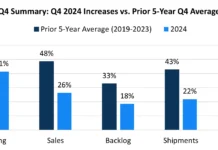by Ashley Turrell Burleson, membership, engagement and analytics manager
MAPP

Seventy-one percent of plastics processors are reporting increased sales today vs. one year ago (Chart 1), and 81 percent anticipate their companies’ sales to continue to grow over the next 12 months, according to the recent State of the Plastics Industry Report from the Manufacturers Association for Plastics Processors (MAPP).
In its 18th year, MAPP’s annual State of the Plastics Industry shows that executives are predicting optimistic trends for their plastics organizations. Data for this report were collected from more than 160 senior-level executives representing companies of a variety of sizes and across an array of processing disciplines. This report helps company leaders benchmark how their companies stack up in comparison to industry norms and aids in calibrating the intuitive “gut feel” that most executives seek to validate.
Multiple indicators in this year’s report suggest a positive climate for plastics processors. Strong first-quarter predictions, capital expenditure plans, new opportunities in medical and automotive markets, and trends in reshoring all point to a healthy 12-month outlook. MAPP’s leadership team examined key questions from this year’s study to develop an overall forecast for the 2018 plastics industry.
Only 50 percent of processors indicated that their companies’ fourth-quarter sales had risen from the previous quarter – a drop of about eight percent from last year’s study. Processors attributed new programs or volume increases with current customers as the main reason for fourth-quarter sales bumps. However, many plastics companies cite the cyclical nature of business to slow sales numbers in the last quarter of 2017.
More plastics executives are hopeful for what the first quarter of 2018 holds, with 66 percent anticipating first-quarter sales this year to be higher than in Q1 2017. Processors that are anticipating a sales increase in the first few months of the new year are predicting an average of a nine percent increase. Processors remain even more optimistic about the rest of 2018, with an average 11 percent increase in sales anticipated over last year.
While there is not as much momentum from the fourth quarter as last year, with fewer processors citing increases in fourth-quarter sales and profits, several key data points suggest that 2018 will quickly ramp up to meet or exceed 2017. Ninety-three percent of companies expect increased or steady work weeks for production employees in Q1, and 48 percent plan to increase the number of production employees in the first three months of the year.

As with previous years, processors continue to report challenges in recruiting and retaining employees. With new programs and increasing volume orders, finding ways to meet customer expectations without human capital means processors must begin relying more heavily on automation, robotics and continuous improvement initiatives to maintain quality and on-time delivery. To that end, it is not surprising that when asked what major activity was planned to increase competitiveness in 2018, 30 percent of processors indicated automation/robotics investments and implementation and 16 percent reported continuous improvement initiatives (Chart 2). As one MAPP sponsor explained,”Automation has gone from a luxury to a necessity” for plastics processors to remain competitive.

New opportunities also may be available soon for plastics companies, as this year’s data show a record-high report of customers relocating work from off-shore back to the United States. Forty-three percent of plastics executives indicated that customers are no longer looking for offshore suppliers, but instead are reshoring work to the US. This figure is up 10 percent from last year and nearly 40 percent from 2008 (Chart 3). This outlook is especially prevalent in processors serving the consumer goods market, with more than half of these processors experiencing customers reshoring their plastics programs.
While sales and profits for plastics companies look positive for 2018, processors are noticing new or increasing barriers to their business. Once again, customer demands top the list of hurdles experienced by plastics executives. Sixty-five percent of processors report that customer demands range from more demanding than usual to downright unreasonable. Escalating quality requirements, speed-to-market expectations, additional standards and an uncertain and changing regulatory environment are all placing burdens on plastics companies. Some executives report putting new processes in place and dedicating additional time to educating customers on opportunities and the realistic limitations of plastics to manage these demands. To top it off, new cybersecurity rules and regulations are now becoming a large concern with the continued expansion of the Internet of Things (IoT).
While plastics executives and their teams face both new and continued challenges over the course of the next 12 months, outlooks for most markets appear positive. Processors that are able to successfully implement and manage the changing work environment while also managing customer expectations should experience a healthy 2018.
Additionally, this year MAPP’s report includes new data based on responses from previous studies, such as customer demands for financials, trends by industry served, plans to improve overall competitiveness and insights from industry experts.
More information or to purchase a copy of the report: www.mappinc.com.




